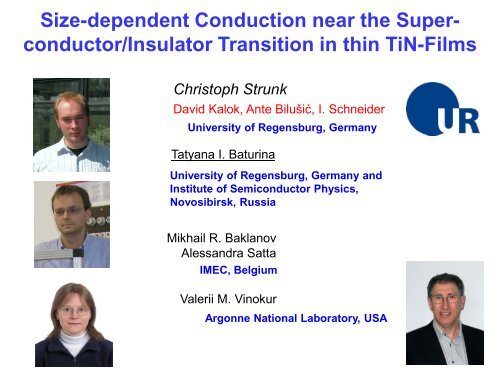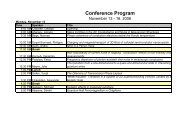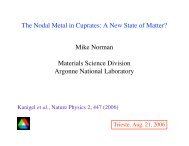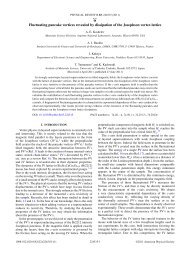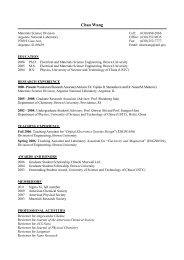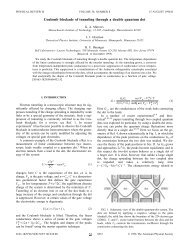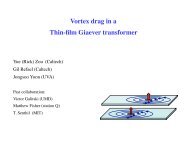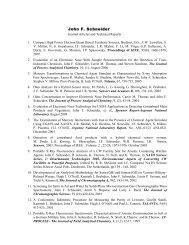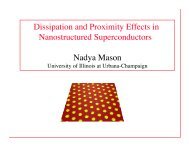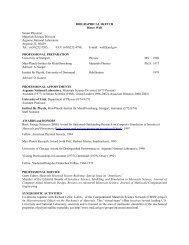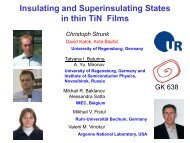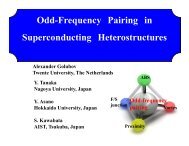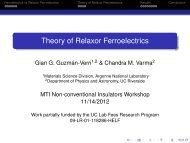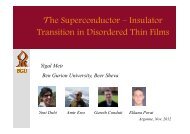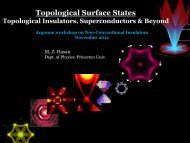Size-dependent Conduction near the Superconductor/Insulator ...
Size-dependent Conduction near the Superconductor/Insulator ...
Size-dependent Conduction near the Superconductor/Insulator ...
You also want an ePaper? Increase the reach of your titles
YUMPU automatically turns print PDFs into web optimized ePapers that Google loves.
<strong>Size</strong>-<strong>dependent</strong> <strong>Conduction</strong> <strong>near</strong> <strong>the</strong> <strong>Superconductor</strong>/<strong>Insulator</strong><br />
Transition in thin TiN-Films<br />
Christoph Strunk<br />
David Kalok, Ante Bilušić, I. Schneider<br />
University of Regensburg, Germany<br />
Tatyana I. Baturina<br />
University of Regensburg, Germany and<br />
Institute of Semiconductor Physics,<br />
Novosibirsk, Russia<br />
Mikhail R. Baklanov<br />
Alessandra Satta<br />
IMEC, Belgium<br />
Valerii M. Vinokur<br />
Argonne National Laboratory, USA
Outline:<br />
• global conductance vs. conductivity<br />
as a probe of long-range interactions<br />
• collective charging energy in arrays of tunnel junctions<br />
resulting from 2-dim Coulomb interaction<br />
• size dependence of R(T), R(B) and I(V)<br />
• comparison to expectations from<br />
Berezinskii-Kosterlitz-Thouless transition<br />
In this talk, 'insulators' are characterized by<br />
an exponential R(T) dependence.
direct superconductor/insulator transition<br />
with Arrhenius-like conductance on <strong>the</strong> insulating side<br />
Bi<br />
A. Goldman ´89<br />
homogeneous TiN-films of 4-18 nm thickness<br />
show a disorder-induced SIT<br />
100M<br />
I3<br />
R<br />
( Ω )<br />
10M<br />
1M<br />
I4<br />
I3<br />
I2<br />
I1<br />
TiN<br />
1M<br />
I1<br />
I4<br />
100k<br />
10k<br />
R<br />
( Ω )<br />
10k<br />
S1<br />
I2<br />
0 5 10 15 20<br />
1/[T(K)]<br />
100<br />
S2<br />
S3<br />
R<br />
( kΩ )<br />
40<br />
20<br />
0<br />
I4<br />
I3<br />
S1<br />
S3<br />
0 1 2 3<br />
T (K)<br />
0,0 0,5 1,0<br />
T (K)
initially positive magnetoresistance in both: metallic<br />
and insulating state<br />
Qualitatively similar behavoir for<br />
insulating and superconducting films<br />
R<br />
( Ω )<br />
100M<br />
1M<br />
10k<br />
100<br />
1<br />
I1: 60 mK<br />
R<br />
( kΩ )<br />
S1: 60 mK<br />
35<br />
30<br />
I1: 700 mK<br />
25<br />
S1: 650 mK<br />
20<br />
0 4 8 12 16<br />
B (T)<br />
0 4 8 12 16<br />
B (T)<br />
Exponential decay of magnetoresistance<br />
at high fields:<br />
gradual suppression of<br />
superconducting OP<br />
Very similar behavior of insulating and<br />
superconducting films for T > 600 mK<br />
Superconductivity important for<br />
insulating behavior !<br />
quasi-metallic<br />
phase at high B<br />
low B:<br />
‚Cooper-pair‘ - insulator !<br />
T. Baturina, C.S. et al., PRL 99, 257003 (2007)
How to model <strong>the</strong> Cooper-pair insulator:<br />
• <strong>the</strong>rmally activated conductance<br />
expt.: Palaanen & Hebard, Ovadyahu, and many o<strong>the</strong>rs<br />
<strong>the</strong>ory: Fistul, Baturina, Vinokur, PRL 100 (2008)<br />
Feigel’man, Ioffe, Kravtsov, Cuevas,<br />
Ann. Physics 325, 1368 (2010);<br />
Feigelman, Ioffe, Mezard, PRB 82, 184534 (2010)<br />
• strongly non-monotonic magnetoresistance<br />
expt.:Gantmakher et al., Shahar et al., Baturina et al. and o<strong>the</strong>rs<br />
Theory: Dubi, Meir, Avishai, Nature 449 876 (2007)<br />
• non-li<strong>near</strong>ities in IV-characteristics<br />
expt. Baturina et al.; Ovadia et al.,<br />
<strong>the</strong>ory: Vinokur et al., Altshuler et al.<br />
emergent inhomogeneity in superconducting condensate<br />
exploit knowledge about Josephson junction array (JJAs)
Josephson arrays in <strong>the</strong> charging regime<br />
"Unbinding of Charge-Anti-Charge Pairs in<br />
Two-Dimensional arrays of small Tunnel Junctions"<br />
J. Mooij, B.J. van Wees, L.J. Geerlings, M. Peters, R. Fazio and G. Schön,<br />
Phys. Rev. Lett. 65, 645 (1990)<br />
consider JJ-arrays in <strong>the</strong><br />
limit E J < E C<br />
superconducting array<br />
turns insulating at much<br />
higher temperatures !<br />
H. v.d.Zant, R. Fazio<br />
Phys. Repts. 355, 235 (2001)
question: what energy scales are relevant in<br />
(disordered) Josephson junction arrays<br />
• <strong>the</strong>rmally activated conductance at T > E C /k B<br />
• collective Coulomb energy:<br />
T<br />
∆ 0 c =<br />
⎧EN<br />
c<br />
/ 2, 1D<br />
= ⎨<br />
⎩ Ec<br />
log N, 2D<br />
N : number of islands<br />
N<br />
=<br />
⎧<br />
min⎨<br />
⎩<br />
L<br />
d<br />
λ ⎫<br />
, ⎬<br />
d ⎭<br />
λ is <strong>the</strong> electrostatic<br />
screening length<br />
Fistul, Vinokur, Baturina, PRL 100, 086805 (2008)
origin of collective Coulomb energy:<br />
1 excess charge polarizes <strong>the</strong> whole array, if λ > L<br />
1dim<br />
−<br />
d<br />
2dim<br />
−<br />
C:<br />
capacitance<br />
between<br />
islands<br />
C 0 :<br />
capacitance<br />
to ground<br />
polarization cloud cut off by screening length λ = d(C/C 0 ) 1/2
charge/anti-charge pairs bound on adjacent islands<br />
cost much less energy:<br />
d<br />
−<br />
+<br />
C:<br />
capacitance<br />
between<br />
islands<br />
C 0 :<br />
capacitance<br />
to ground<br />
adjacent charges cost charging energy E C<br />
seperating charges costs collective charging energy ∆ C = E C /2 ln (L/d)<br />
logarithmic interaction between charges in array
How to check <strong>the</strong> relevance of JJ-array models<br />
and/or Coulomb charging effects experimentally<br />
Look for size dependence of transport properties:<br />
• size <strong>dependent</strong> activation energy <br />
• size <strong>dependent</strong> magnetoresistance <br />
• I(V) – characteristics
240 µm<br />
dependence of<br />
R on sample size:<br />
0.5 µm<br />
5 µm<br />
prepare squares<br />
between 0.5 and<br />
500 µm side length<br />
500 µm
characterization of <strong>the</strong> TiN films<br />
TiN films were formed by atomic layer chemical<br />
vapor deposition onto a Si/SiO 2 substrate at 350 0 C.<br />
thickness d = 5 nm carrier density n = 2-4 10 22 cm -3<br />
depending on stochiometry<br />
Composition:<br />
Ti N Cl<br />
1 0.94 0.035 ξ d ~ 9 nm superconducting coherence length
controlled oxidation of TiN films in air<br />
R <br />
at room temperature (kΩ)<br />
4<br />
3<br />
2<br />
1<br />
d=5 nm, superconducting at B=0<br />
SIT<br />
320<br />
305<br />
290<br />
250<br />
0 5 10 15 20 25 30<br />
time (min)<br />
T (°C)<br />
annealing<br />
temperature
Is <strong>the</strong>re granularity in TiN<br />
Two possiblities:<br />
structural granularity<br />
Stranski-Krastanov (island) growth<br />
mode: film closure at d = 4nm<br />
preferred oxidation at grains<br />
boundaries<br />
'self-induced' granularity<br />
disorder potential produces<br />
Josephson coupled SC 'droplets'<br />
Kowal & Ovadyahu, Sol.Stat. Comm '94<br />
Trivedi et al. PRL '98<br />
Sacepe et al. PRL 2008, Nat.Phys. 2011<br />
Bouadim, et al. Nat.Phys. 2011
R (T) is indeed size <strong>dependent</strong>:<br />
• sample insulating at B = 0<br />
10G<br />
• each point extracted from<br />
full IV-characteristic<br />
R <br />
[Ω]<br />
100M<br />
1M<br />
L [µm]<br />
500<br />
240<br />
20<br />
5<br />
2<br />
0.5<br />
• larger samples more<br />
insulating<br />
• saturation of R at low T,<br />
except for <strong>the</strong> largest<br />
samples<br />
10k<br />
0 10 20 30 40<br />
1/T [1/K]<br />
• Arrhenius behavior at<br />
higher temperature
magnetoresistance strongly depending on sample size<br />
R (Ω)<br />
1G<br />
100M<br />
10M<br />
1M<br />
T = 82 mK<br />
B sweeps up<br />
240 um<br />
20 um<br />
5 um<br />
2 um<br />
0.5 um<br />
100k<br />
10k<br />
0 5 10 15 20 25 30<br />
B (T)<br />
Measurement at High Magnetic Field Laboratory Nijmegen
size <strong>dependent</strong> IVs display cross-over from<br />
li<strong>near</strong> to nonli<strong>near</strong> behavior at low T<br />
I (A)<br />
100n<br />
10n<br />
1n<br />
100p<br />
10p<br />
1p<br />
100f<br />
10f<br />
T = 28 mK<br />
0.5 µm<br />
5 µm<br />
20 µm<br />
240 µm<br />
1f<br />
10m 100m 1 10<br />
V (mV)
size <strong>dependent</strong> IVs display cross-over from<br />
li<strong>near</strong> to nonli<strong>near</strong> behavior at low T<br />
I /L (A/m)<br />
100m<br />
10m<br />
1m<br />
T = 28 mK<br />
100µ<br />
10µ<br />
0.5 µm<br />
1µ<br />
100n<br />
10n<br />
5 µm<br />
1n<br />
100p<br />
20 µm<br />
10p<br />
1p<br />
240 µm<br />
100f<br />
1 10 100<br />
V /L (V/m)<br />
1k
extract size <strong>dependent</strong> activation energy:<br />
10M<br />
(d)<br />
logarithmic increase<br />
of T 0 with size L<br />
R <br />
[Ω]<br />
1M<br />
1.5<br />
sample I<br />
100k<br />
T 0<br />
[K]<br />
1.0<br />
0 3 6<br />
1/T [1/K]<br />
0.5<br />
1 10 100<br />
L [µm]
extract network parameters governing activation energy:<br />
1.5<br />
sample I<br />
1.0<br />
T 0<br />
[K]<br />
0.5<br />
0.0<br />
0.01 0.1 1 10 100<br />
L [µm]
employ continuum model to extract dielectric constant:<br />
0<br />
-1<br />
-2<br />
electrostatic<br />
penetration depth<br />
-3<br />
-4<br />
-5<br />
-6<br />
0<br />
10µ 100µ 1m 10m 100m<br />
10 -4 10 -3 10 -2 10 -1 10 0<br />
15<br />
10<br />
5<br />
compatible with<br />
measured sizes<br />
L. V. Keldysh, JETP Lett. 29, 658 (1979)<br />
interaction energy between charge/anti-charge pair:<br />
for d
explanation for large values of ε <br />
a) localized Cooper-pairs for droplets in superconducting matrix:<br />
superconducting films (see B. Sacepe, Nat. Phys 2011)<br />
b) insulating droplets form percolating network wirh diverging ε<br />
at <strong>the</strong> percolation threshold<br />
superconductor/insulator transition<br />
c) superconducting droplets in insulating matrix<br />
Cooper-pair insulator<br />
to be verified experimentally!
ehavior not far from Efros-Shklovskii,<br />
R <br />
[Ω]<br />
100G<br />
10G<br />
1G<br />
100M<br />
10M<br />
1M<br />
100k<br />
B = 0 T<br />
L [µm]<br />
500<br />
240<br />
20<br />
5<br />
2<br />
0.5<br />
but deviations at<br />
• high temperature:<br />
~ exp (T 0 /T)<br />
• low temperature:<br />
−<br />
upturn in<br />
large samples<br />
− saturation in<br />
small samples<br />
0 2 4 6<br />
T -1/2 [K -1/2 ]<br />
see also tin/graphene granular films:<br />
A. Allain, Z. Han, and V. Bouchiat,<br />
Nature Materials 11, 590 (2012).
Charge Berezinskii-Kosterlitz-Thouless transition<br />
• Combine free motion of particles in 2d with<br />
logarithmic interaction potential<br />
competition between binding energy and entropy<br />
binding/un-binding transition of pairs of particles<br />
• applicable to superconducting (vortices) and<br />
insulating (charges) side of <strong>the</strong> transition<br />
E C : charging energy of single island
Charge-Berezinskii-Kosterlitz-Thouless transition<br />
• high temperature regime: T >> T BKT<br />
mobile charges with a density ~ exp (-∆ C /2k B T)<br />
<strong>the</strong>rmally activated conductance<br />
• low temperature regime: T ~ T BKT<br />
binding into (neutral) charge/anti-charge pairs<br />
very few residual mobile charges<br />
with density<br />
Fistul, Vinokur, Baturina PRL 100 (2008)<br />
• ξ(T) is a correlation length describing <strong>the</strong> distance<br />
between charged excitations<br />
J. E. Mooij et al., PRL. 65, (1990).
est fit: BKT-like 'square-root cusp formula'<br />
100G<br />
10G<br />
1G<br />
B = 0 T<br />
where<br />
R <br />
[Ω]<br />
100M<br />
10M<br />
1M<br />
100k<br />
L [µm]<br />
500<br />
240<br />
20<br />
5<br />
2<br />
0.5<br />
0 5 10 15<br />
(T-40 mK) - 1/2 [K - 1/2 ]<br />
and A and b are constants of order 1<br />
is <strong>the</strong> BKT-transition temperature<br />
extracted from <strong>the</strong><br />
size-dependence T 0 (L)<br />
Divergence of R(T) is expected to<br />
be cut-off at ξ(T) = L :<br />
Explanation of saturation of R(T) !
ough estimate of ξ 0 from saturation temperatures<br />
<strong>the</strong> condition ξ(T) = L<br />
leads to :<br />
L. Benfatto et al., PRB 80, 214506 (2009)<br />
ξ 0 represents a minimal<br />
distance of charge solitons<br />
(analog to size of vortex core)
BKT physics: I-V characteristics (vortices)<br />
Voltage, log(V)<br />
T > T BKT<br />
α = 1<br />
α > 3<br />
T < T BKT<br />
Current, log(I)<br />
V ∝ Ι α(Τ)<br />
A dual (I V) scenario<br />
is expected to hold in <strong>the</strong><br />
charge regime E C > E J<br />
28
strongly non-li<strong>near</strong> IV-characteristics at <strong>the</strong> lowest T:<br />
I [A]<br />
10n<br />
1n<br />
100p<br />
10p<br />
1p<br />
100f<br />
10f<br />
100 mK<br />
80 mK<br />
70 mK<br />
60 mK<br />
50 mK<br />
45 mK<br />
42 mK<br />
40 mK<br />
37 mK<br />
100 mK<br />
60 mK<br />
B ⊥<br />
= 0.9 T<br />
0.1 1 10<br />
V [mV]<br />
32 mK<br />
B ||<br />
= 1.5 T<br />
intermediate temperature:<br />
(50 mK < T < 300 mK):<br />
jump probably induced by electron<br />
heating<br />
see data in InO x (Weizmann)<br />
Sambandamurthy 150 et al. mK PRL (2005)<br />
Ovadia et al. PRL 100 102 (2009) mK<br />
Altshuler et al., PRL 80102 mK (2009)<br />
70 mK<br />
60 mK<br />
At <strong>the</strong> lowest T: 50 mK<br />
45 mK<br />
I(V) develops power 40 law mK behavior<br />
with exponent α(T) 35 mK<br />
30 mK<br />
random scatter of switching 26 mK voltage<br />
26 mK<br />
nature of insulating state<br />
150 mK<br />
α = 1<br />
0.1 1 10<br />
V [mV]
I [A]<br />
2.8 GΩ<br />
100f<br />
50f<br />
0<br />
Ano<strong>the</strong>r sample – insulating at B = 0<br />
1 TΩ<br />
0 3 6 9<br />
V [mV]<br />
T [mK]<br />
78.7<br />
69.5<br />
60.1<br />
50<br />
40<br />
32<br />
23<br />
70 mK<br />
L = 240 µm<br />
B = 0<br />
32 mK<br />
23 mK<br />
10p<br />
1p<br />
100f<br />
10f<br />
0.1 1 10 1f<br />
V [mV] α = 3<br />
I [A]<br />
α = 4
Charge-Berezhinski-Kosterlitz-<br />
Thouless-like transition<br />
smeared by disorder<br />
L. Benfatto et al., PRB 80 (2009)<br />
IV characteristics become<br />
non-li<strong>near</strong> below 60 mK<br />
power law<br />
α<br />
7<br />
6<br />
5<br />
4<br />
3<br />
2<br />
with strongly T- <strong>dependent</strong><br />
exponent α(T)<br />
BKT transition usually<br />
assigned to α = 3<br />
1<br />
20<br />
T BKT<br />
100<br />
T [mK]<br />
very good agreement with<br />
in<strong>dependent</strong> estimate of<br />
T BKT from activation energies
Conclusions<br />
- dramatic size dependence of all transport properties<br />
<strong>near</strong> <strong>the</strong> SIT<br />
- this size dependence can be explained in terms of a<br />
charge-BKT-transition, i.e., a large electrostatic<br />
penetration depth and a diverging correlation length<br />
- non-li<strong>near</strong> I(V)-characteristics coincide very well with analysis of size<br />
dependence<br />
<strong>the</strong> conductance vanishing at finite T BKT supports <strong>the</strong> notion of a<br />
'superinsulator' Vinokur et al., Nature 452 (2008)<br />
Open Questions<br />
- direct measurement of dielectric constant<br />
- hyperactivated behavior<br />
- role of quantum phase slips, or analogous processes<br />
-role of electron heating effects


